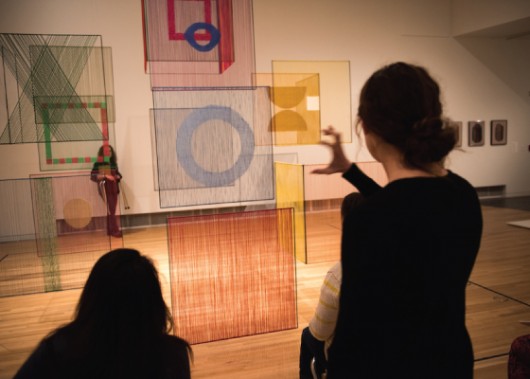The Wexner Center for the Arts is promoting both wellness for individuals living with brain injuries and the social experience of learning about art in a program titled Art on the Brain.
Art on the Brain is a program that has a concentration on art analysis to improve cognitive function, and will be the focus of the next series of public programs at the Wexner Center from Oct. 15 through Dec. 17.
Tracie McCambridge, educator for Docent and Teacher Programs at the Wexner Center and founder of the Art on the Brain program, wouldn’t call Art on the Brain medicine, but said she agrees that that individuals who participate in these types of activities can achieve total wellness.
“My favorite thing about the program is when people discover strengths that they did not realize they had, revealing that just because it’s dormant does not mean it’s not there,” McCambridge said in an email. “For instance, someone who thinks very linearly might say something very metaphorical or imaginative, and they might not realize that they are accessing a different part of their brain and how this is a strength.”
The series works with individuals with brain injuries and their loved ones to learn how to look at art through interpretation to stimulate parts of their brains.
Art on the Brain aims to promote discussion about exploring art specifically for individuals whose thinking processes were derailed and want help realigning, or are struggling with their focus or cannot articulate their thoughts as well as they would like, McCambridge said.
McCambridge started the program with attention toward who else would benefit from inquiry-based tours that guide people to interpret art using visual evidence.
“Brain injury especially can feel isolating — people can’t see the injury so they assume you are better. An injury can change your personality, so you might be withdrawn from friends and family,” she said.

Tracie McCambridge, Wexner Center Educator for Docent and Teacher Programs, works with her students at an Art on the Brain tour. Credit: Courtesy of Jo McCulty
Lise Worthen-Chaudhari, a researcher at the Wexner Medical Center at The Ohio State University’s Neurological Institute said it is unusual for individuals with a brain injury to use art in their rehabilitation.
“Sometimes people are offered art therapy to help them express themselves or navigate their emotions during recovery, but art is not generally used for cognitive or physical rehabilitation. Ohio State is unique in having programs that use art to help cognitive and physical rehabilitation,” Worthen-Chaudhari said in an email.
McCambridge said that art and music therapies are different from Art on the Brain because of the social element. She added that socializing in a public space, such as the medical center, versus a hospital is also very different.
“I’ve noticed that when the participants are in a group of people who completely understand the situation, they feel more comfortable in their skin. I have seen participants in the program become a lot more social, for instance, groups of people getting together for dinner after the program because they want to talk with their new friends,” she said.
Art on the Brain is a program not available at all medical centers.
“We are very lucky to have support from OSU Wexner Medical Center leaders in the Neurological Institute to integrate innovative uses of art within our rehabilitation medicine services,” Worthen-Chaudhari said.
She added that individuals can temporarily forget their injuries and enjoy time with their loved ones.
Individuals living with brain injuries interested in this program should be past the acute phase of their recovery, should be able to travel to the Wexner Center and attend each class. Caregivers and loved ones of those with individuals living brain injuries are welcome to come to classes as participants as well.
Correction
October 8, 2015
A quote in this story was incorrectly attributed to Tracie McCambridge. Instead, the quote of being lucky to have support from OSU Wexner Medical Center leaders in the Neurological Institute to integrate innovative uses of art within the rehabilitation medicine services should be attributed to Lise Worthen-Chaudhari.



